Current Articles
2025, Volume 39, Issue 2
Display Method:
2025,
39(2):
119-124, 222.
doi: 10.12299/jsues.24-0080
Abstract:
2025,
39(2):
125-130.
doi: 10.12299/jsues.24-0048
Abstract:
2025,
39(2):
131-140, 173.
doi: 10.12299/jsues.24-0053
Abstract:
2025,
39(2):
141-147.
doi: 10.12299/jsues.23-0244
Abstract:
2025,
39(2):
148-156, 180.
doi: 10.12299/jsues.24-0068
Abstract:
2025,
39(2):
157-165.
doi: 10.12299/jsues.24-0097
Abstract:
2025,
39(2):
166-173.
doi: 10.12299/jsues.24-0043
Abstract:
2025,
39(2):
174-180.
doi: 10.12299/jsues.24-0085
Abstract:
2025,
39(2):
181-186.
doi: 10.12299/jsues.24-0272
Abstract:
2025,
39(2):
187-193.
doi: 10.12299/jsues.24-0081
Abstract:
2025,
39(2):
194-200, 208.
doi: 10.12299/jsues.24-0049
Abstract:
2025,
39(2):
201-208.
doi: 10.12299/jsues.24-0072
Abstract:
2025,
39(2):
209-215.
doi: 10.12299/jsues.24-0070
Abstract:
2025,
39(2):
216-222.
doi: 10.12299/jsues.24-0063
Abstract:
2025,
39(2):
223-228.
doi: 10.12299/jsues.24-0079
Abstract:
2025,
39(2):
229-235.
doi: 10.12299/jsues.24-0075
Abstract:
2025,
39(2):
236-242.
doi: 10.12299/jsues.24-0087
Abstract:
2025,
39(2):
243-250.
doi: 10.12299/jsues.24-0074
Abstract:
2025,
39(2):
251-256.
doi: 10.12299/jsues.24-0073
Abstract:




 Email Alert
Email Alert
 RSS
RSS
